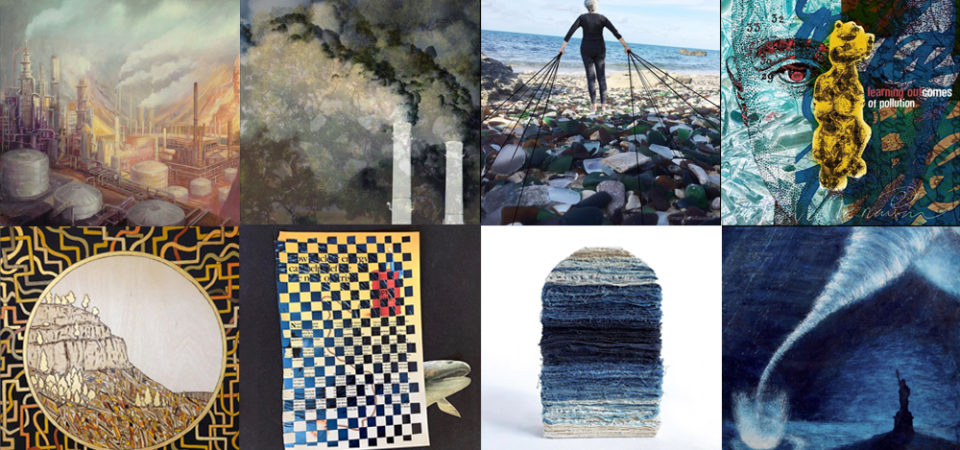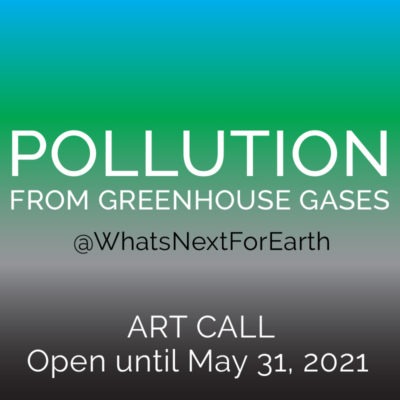 Thanks to all the artists who contributed to the Pollution art call, based on Think Resilience, the Post Carbon Institute’s free online course. To respond to the art call, we asked the artists to signup and to watch the course one lesson at a time:
Thanks to all the artists who contributed to the Pollution art call, based on Think Resilience, the Post Carbon Institute’s free online course. To respond to the art call, we asked the artists to signup and to watch the course one lesson at a time:
Lesson 1: Introduction
Lesson 2: Energy
Lesson 3: Population and Consumption
Lesson 4: Depletion (precedent art call)
Lesson5: Pollution
With “Pollution” we are closing “Our Converging Crisis”, the first chapter of the course.
Next, we will explore The Roots and Results of Our Crises, the role of human behavior in our sustainability crises, and dig deeper into where those crises are taking us:
Lesson 6- Political & Economic Management
Lesson 7- Belief Systems
Lesson 8- Biodiversity
Lesson 9- Collapse
Each video is approximately 12 minutes long.
Pollution (excerpt of the video – Full video transcript here)
“In nature, waste from one organism is food for another. However, that principle sometimes breaks down and waste becomes poison. Humans aren’t the only possible sources of environmental pollution. But these days the vast majority of pollution does come from human activities. That’s because we humans are able to use energy and tools to extract, transform, use, and discard natural resources, producing wastes of many kinds and in ever-larger quantities.”
Think Resilience is hosted by Richard Heinberg, one of the world’s leading experts on the urgency and challenges of moving society away from fossil fuels.
We live in a time of tremendous political, environmental, and economic upheaval. What should we do? Think Resilience is an online course offered by Post Carbon Institute to help you get started on doing something. It features twenty-two video lectures—about four hours total—by Richard Heinberg, one of the world’s foremost experts on the urgency and challenges of transitioning society away from fossil fuels. Think Resilience is rooted in Post Carbon Institute’s years of work in energy literacy and community resilience. It packs a lot of information into four hours, and by the end of the course you’ll have a good start on two important skills:
1. How to make sense of the complex challenges society now faces. What are the underlying, systemic forces at play? What brought us to this place? Acting without this understanding is like putting a bandage on a life-threatening injury.
2. How to build community resilience. While we must also act in our individual lives and as national and global citizens, building the resilience of our communities is an essential response to the 21st century’s multiple sustainability crises.
Featured artists
Marianne Bickett, Christina Conklin, Fabani, Michele Guieu, Terri Hugues-Oelrich, Deborah Kennedy, Pascal Ken, Michael Kerbow, Abby Lindstrom King, Suzette Marie Martin, Quin de la Mer, Marcela Villaseñor, Rachael Wellisch.
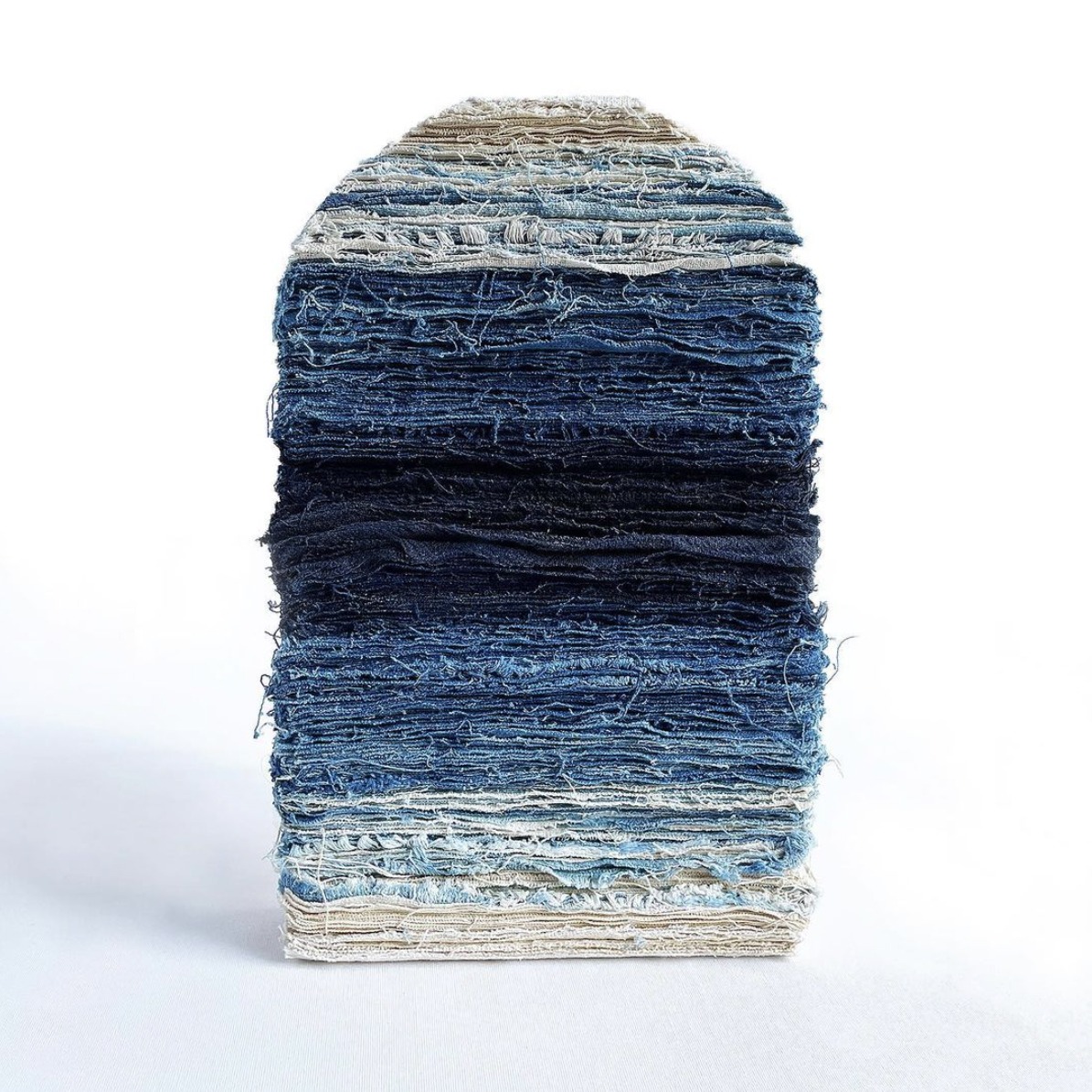
Rachael Wellisch
Instagram: @rachael_wellisch
Monumental Schists
2021
New artwork made from salvaged textile waste, hand-dyed with indigo, and layered up a piece at a time to form this arched monument.
I’m continuously alarmed by the scale of impact of the textiles industry on the environment. For example, it is estimated that the fashion industry is responsible for 10% of global carbon emissions – more than international flights and maritime shipping combined. Also, according to the European Environment Agency, textile purchases in the EU in 2017 generated about 654 kg of CO2 emissions per person. Circularity is something that needs to be implemented and legislated.
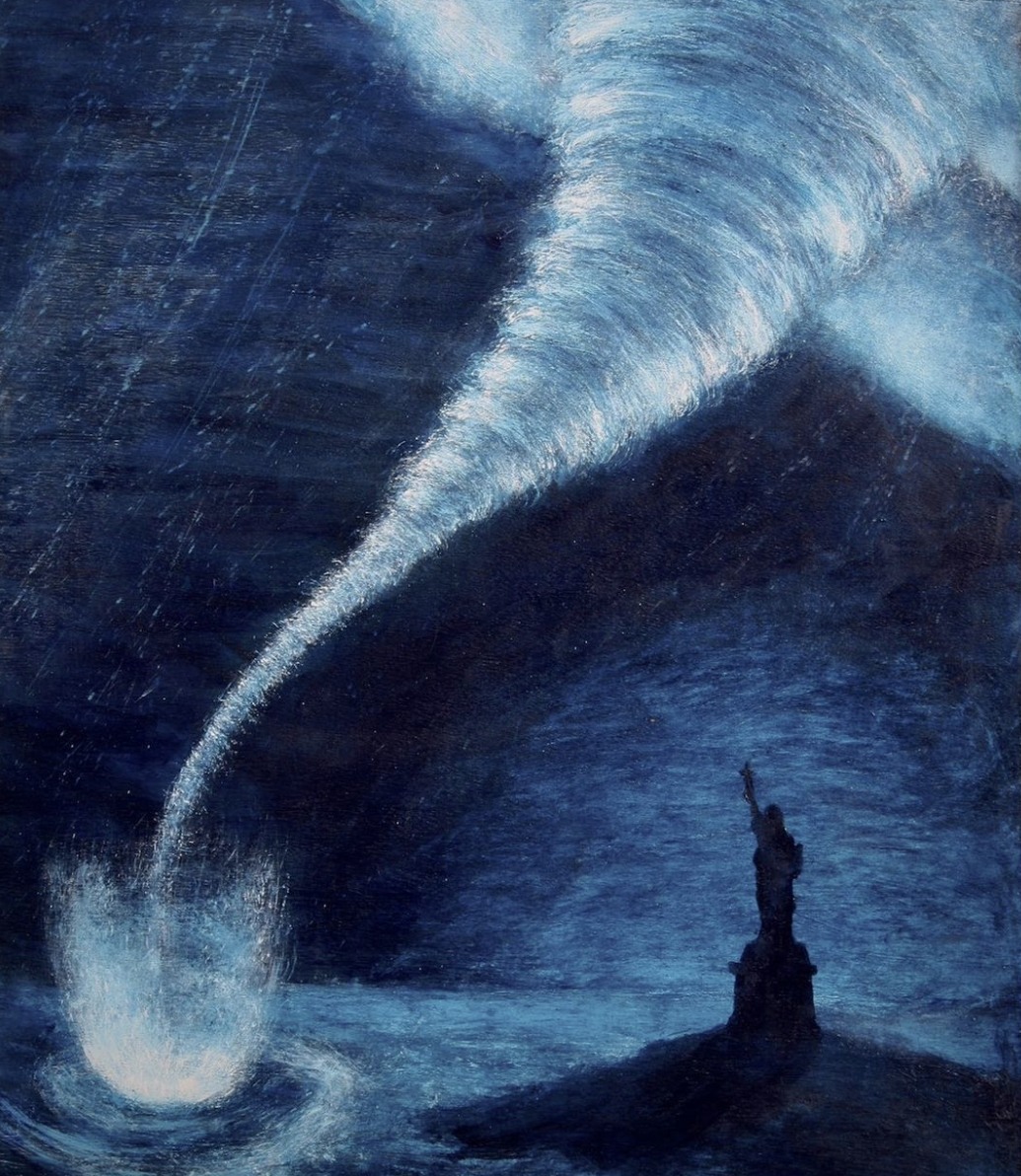
Deborah Kennedy (California, US)
Instagram @deborahkennedyart
Hard Rain: Waterspout and the Statue of Liberty (Detail)
A waterspout is a tornado that forms over water and draws water up into a cup shape at the base of this severe weather event. Climate change is predicted to increase the number and intensity of severe weather events. Our government could curtail climate change, but climate change can also affect our government and our national symbols. Hopefully, most people understand the devastating relationship between our air pollution from burning fossil fuels and other materials are creating increasingly dangerous changes in our climate.
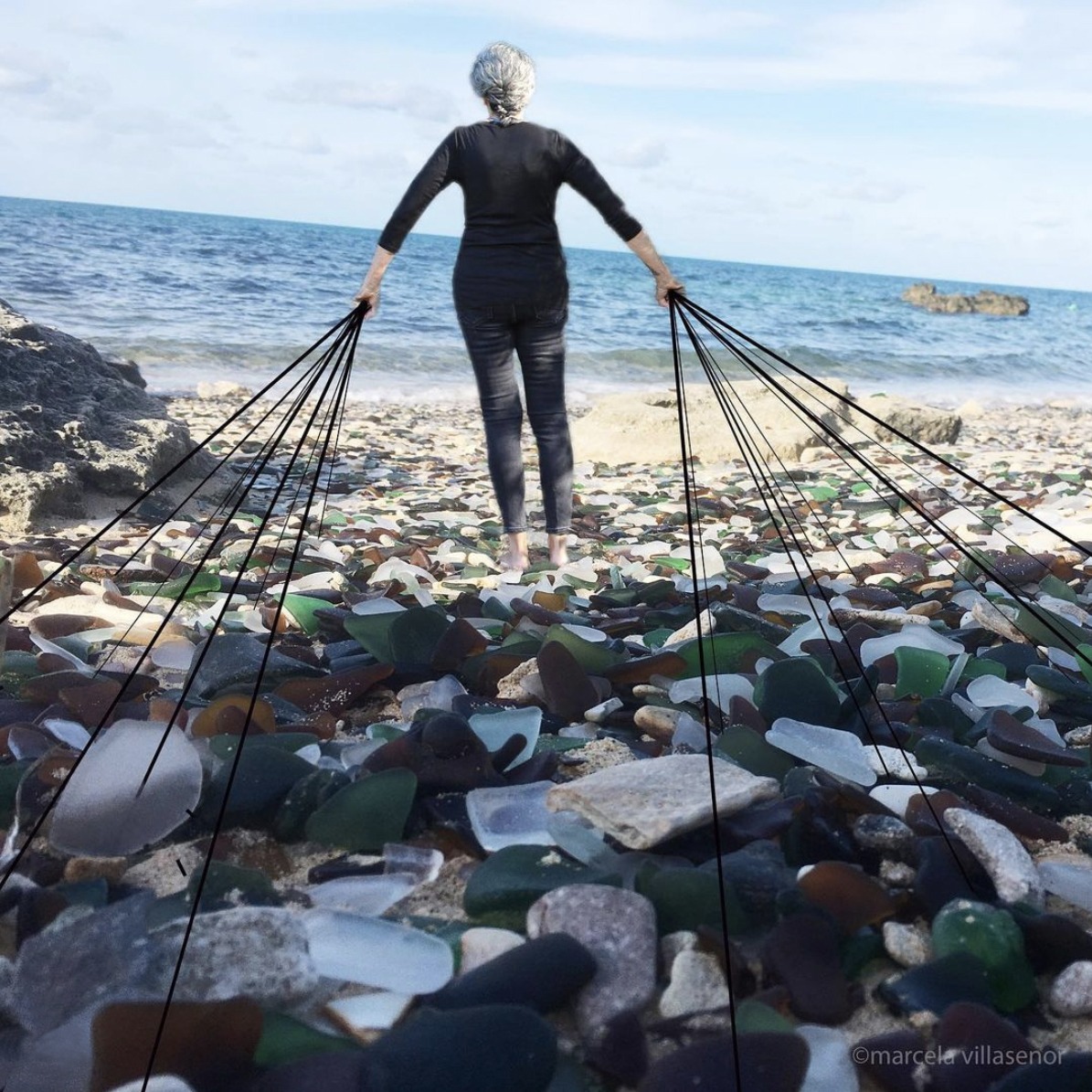
Marcela Villaseñor (California, US)
Instagram: @mvillasenor
Landscape-Timeline
2021
digital photography
Mandatory Reporting of Greenhouse Gases (GHGs) rule, owners or operators of facilities that contain glass production processes (as defined below) and that emit 25,000 metric tons or more of GHGs per year (expressed as carbon dioxide equivalents) from glass production processes, stationary combustion, miscellaneous use of carbonates, and other source categories.
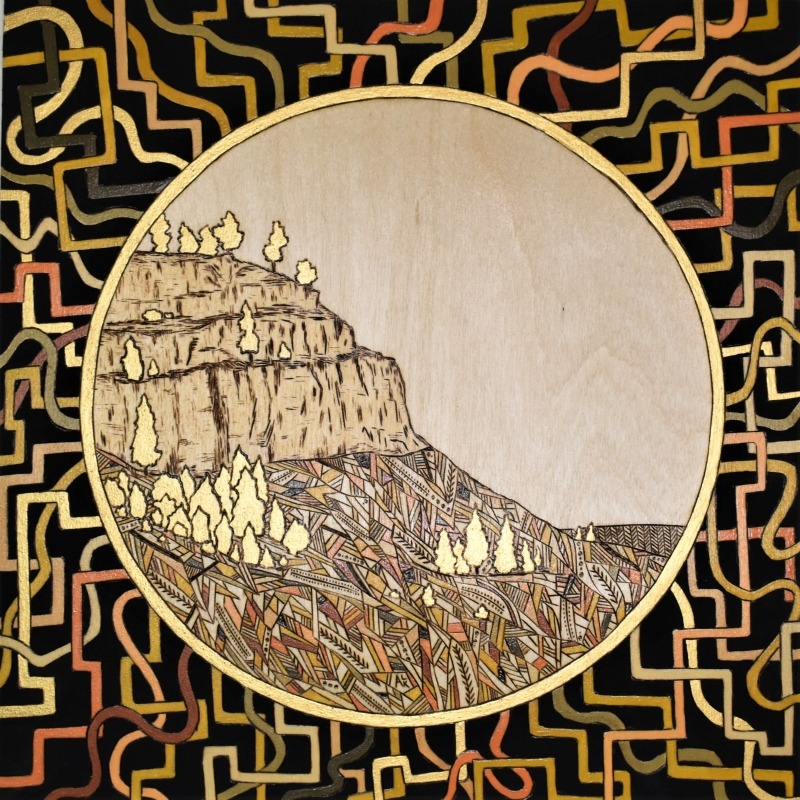
Abby Lindstrom King (Billings, Montana)
Instagram @alkingart
Golden Hour Rimrocks
mixed media: acrylic painting and pyrography pen drawing on wood panel
12″x12″
I live in Billings, which boasts beautiful yellow sandstone rimrocks, the gorgeous Yellowstone River, and three oil refineries. For years multi-national and multi-state energy companies have polluted Billings with little or no consequence. As the city grows and modernizes, I can’t help but wonder what our future will look like here in Montana. My work represents both my hope and my fear. Hope that my local community will hold these incredibly wealthy companies responsible for the damage they cause and to make sure their deep pockets pour funds directly into the places they pollute. Fear that my community will continue to put profit over people, giving these fossil fuel companies free rein to damage our air, water, and soil until all that’s left is another superfund site in Montana. I’m choosing to look forward to hope, that our care and preservation of the stunning natural resources in Billings will continue to expand into the darkness the fossil fuel industry has left in our city.
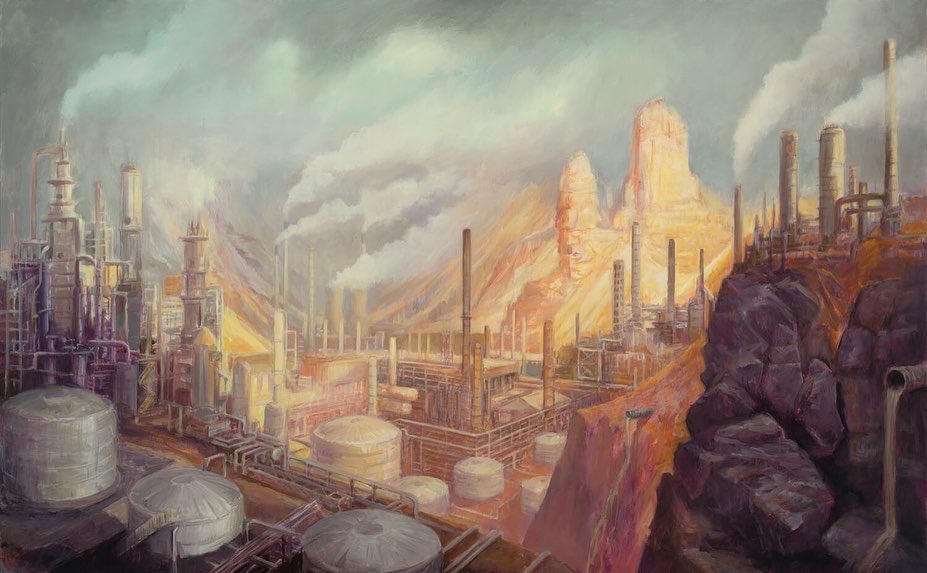
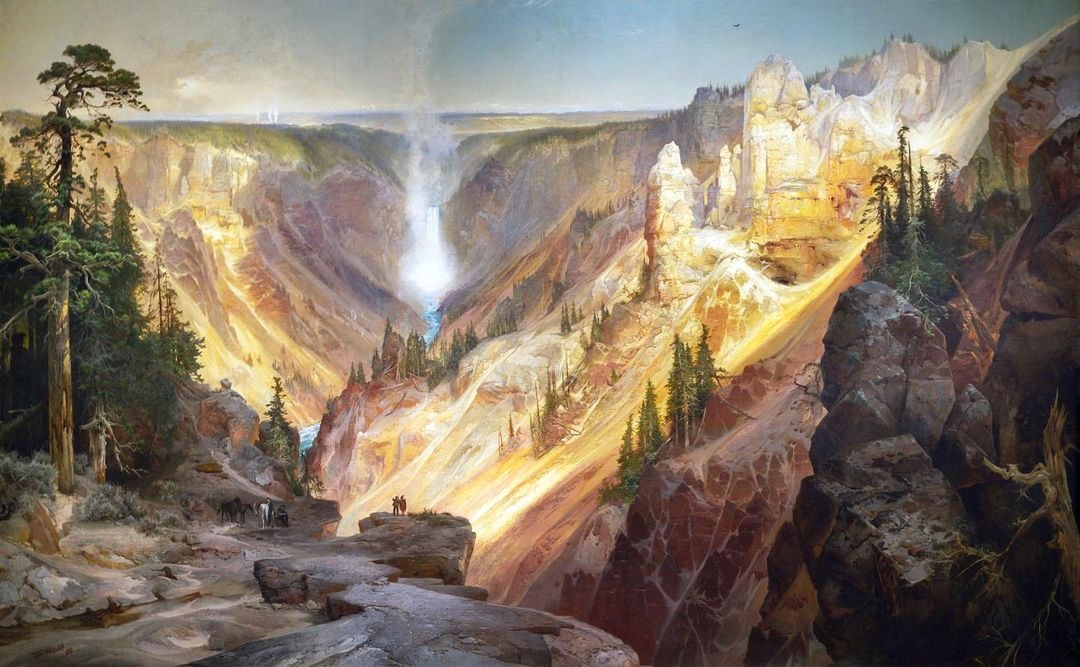
Michael Kerbow (San Francisco, California)
Instagram: @michaelkerbow
Gorge
My painting “Gorge” (top) was inspired by Thomas Moran’s 19thC work “The Grand Canyon of the Yellowstone”(bottom).
I envisioned this place as carpeted with factories and refineries. While Moran sought to convey the sublime beauty of nature, my work attempts to portray a scenario where corporate interests have usurped control, in their quest to extract every natural resource for financial gain. Fortunately, we still have protected places in this world, but our collective actions are having a global impact, so nowhere is entirely safe from harm.
Quin De La Mer (Indian Wells, California, US)
Instagram: i3rstudios
Cold, Sharp and Merciless (video)
Cold Sharp & Merciless is a short film created for the art call, Pollution from Greenhouse Gases, @whatsnextforearth. Deeply upset by the impact of environmental pollutions supported by industrial consciousness, this work recognizes Climate Change as the most serious problem caused by human-produced greenhouse gases. Most important, Climate Change causes the extinction of our global ecosystem. That is to say … mass global extinction. With special thanks to Post Carbon Institute, Richard Heinberg, for making Think Resilience a free online course available to all! If interested, go to: education.resilience.org
Quin de la Mer ©2021
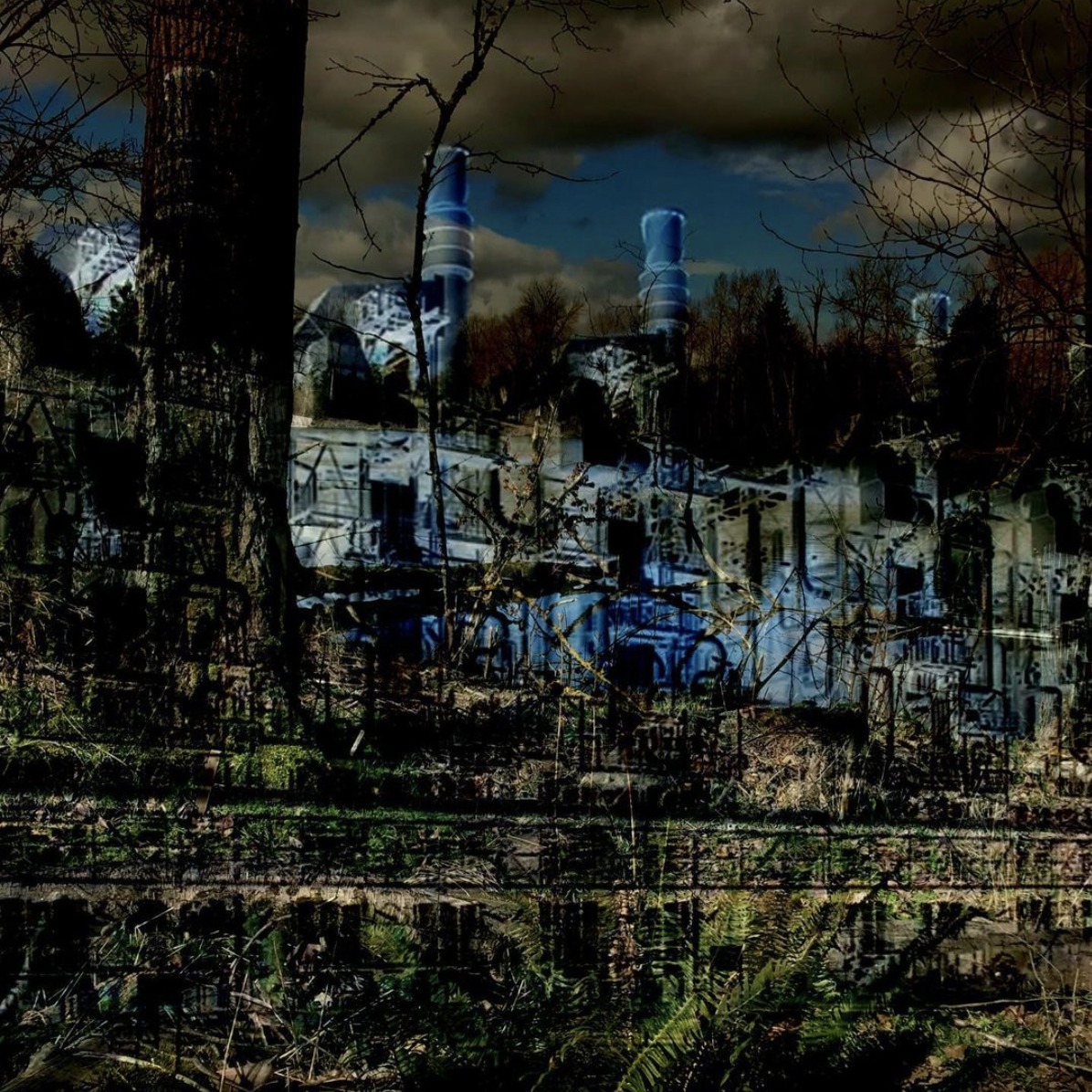
Quin De La Mer (Indian Wells, California, US)
Instagram: i3rstudios
Climate Change, Global Extinction
Climate Change, Global Extinction is a digital art piece created for the art call, Pollution from Greenhouse Gases.

Quin De La Mer (Indian Wells, California, US)
Instagram: i3rstudios
Climate Change, Global Extinction
Climate Change, Global Extinction is a text as medium piece created for the art call, Pollution from Greenhouse Gases, @whatsnextforearth.
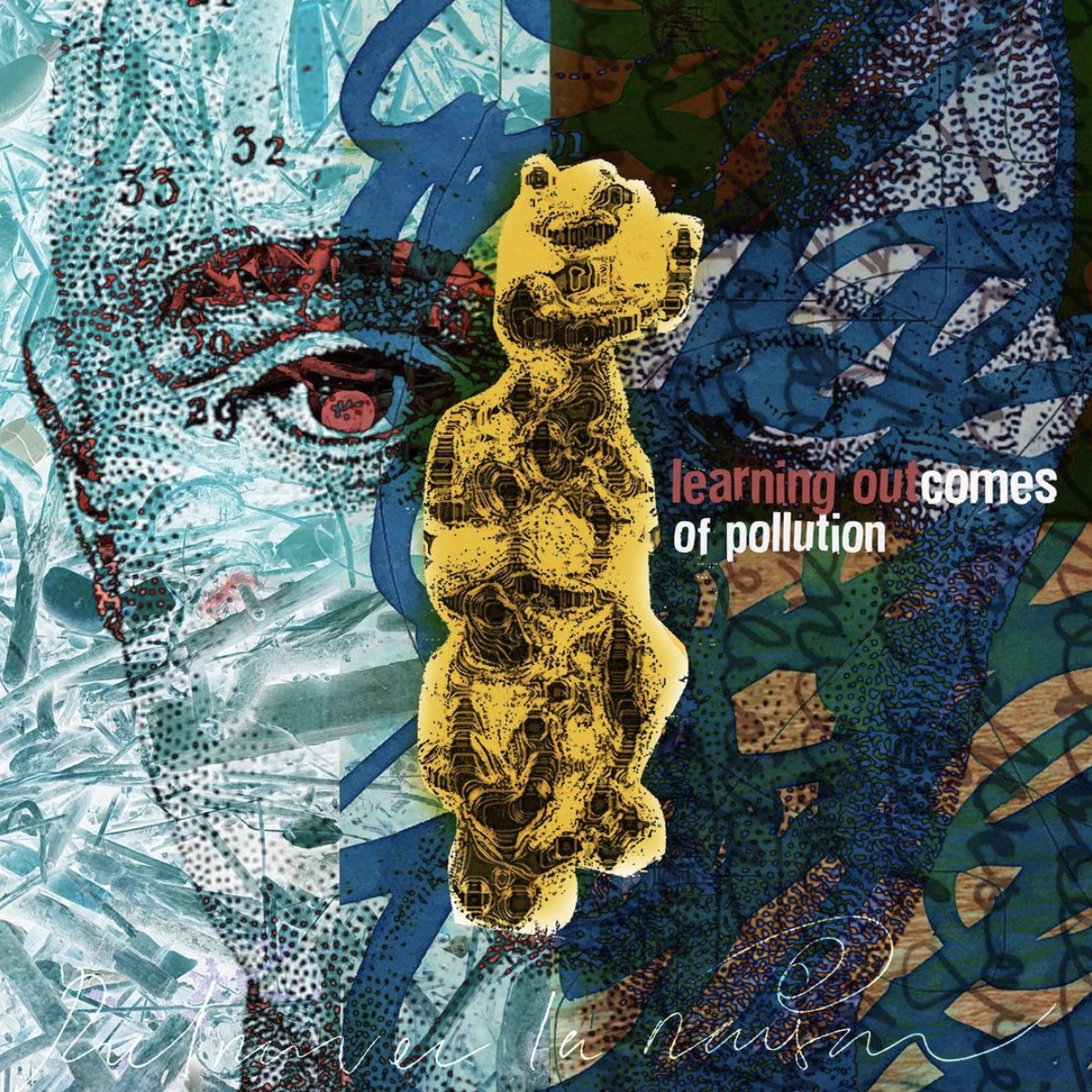
Pascal Ken (Saint-Brévin-Les-Pins, France)
Instagram: @pascalken
Learning Outcomes Of Pollution
15cmx15cm Photography
Yakushima island Pacific Ocean Japan
Calligraphy digital collage

Christina Conklin (California)
Instagram bychristinaconklin
This funny little climate collage is me thinking about Pollution, especially in the ocean, where carbon dioxide and methane from fossil fuels and radiation from nuclear meltdowns weave with the waters and life forms into a complex soup of being.
The images, from 1970s National Geographic magazines, are: an ad touting how nuclear energy can help us “defuse” the next oil crisis; a diver surrounded by a halo of fish; a drawing of an enormous sea creature, now long extinct.
How do we relate to the ocean? Where does our waste go? Why is the heat on in my house right now, even though I’m not cold? These are the questions we must be asking ourselves and each other every day.
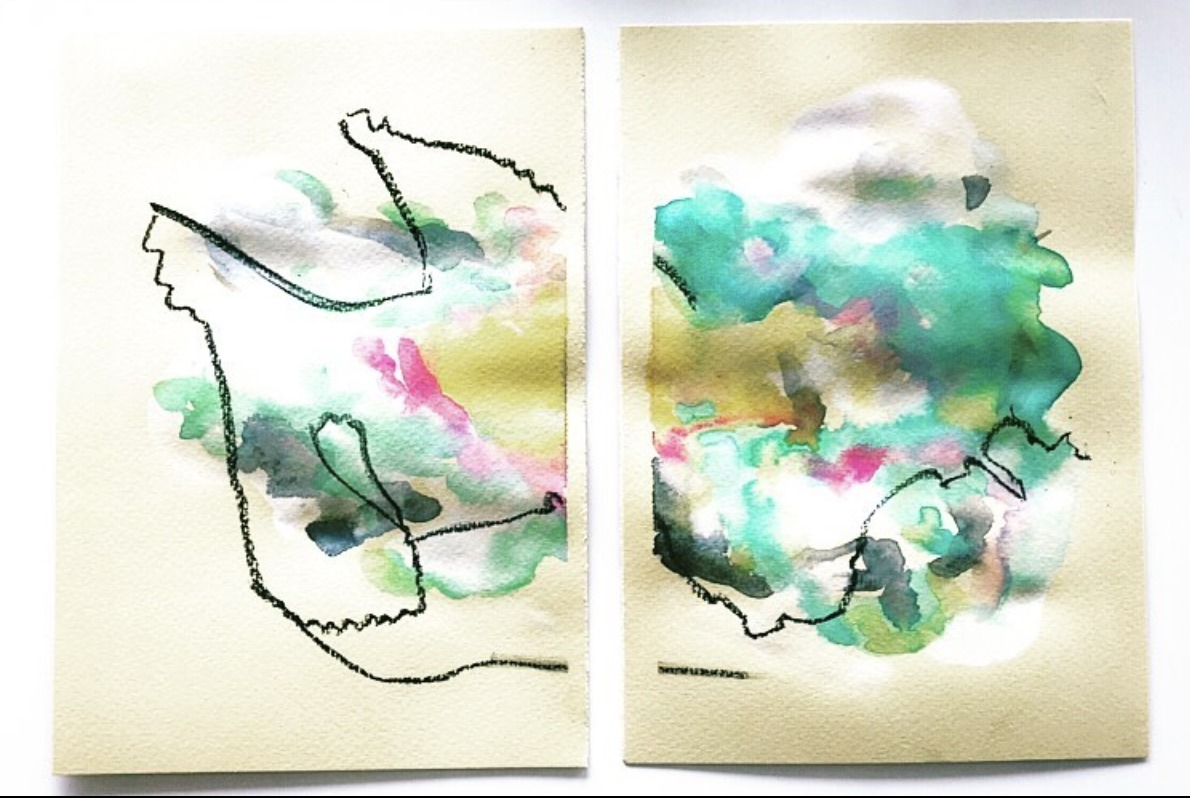
Fabani
Instagram: @fabani
hEARTh
21×30 cm
Watercolor on acid-free paper from responsible source.
Fixing something isn’t always the solution… sometimes when we approach a challenge by wanting to fix it we may lose the capacity to learn to place ourselves above it or separate from it. Maybe even detaching from the challenge we are actually part of. Resolution might come by actively participating and relating to what needs to change. The climate disaster (and so many challenges like wars, pandemics, racism…) might need resolution, healing, learning, and not just fixing. Healing, like learning, is inquiry-oriented, long-term, creative, and proactive. That to me is connective and imaginative. The colors come out to sense my way into “What’s Next for Earth”.
Fabani
Instagram: @fabani
Vital
I wrote this poem at the beginning of the pandemic. First in Italian, then I translated into English.
Divided between profiting and caring
Divided between shining and illuminating
Divided between abandoning and holding close
A pandemic where the virus infecting us all is “versus”.
A viral way of thinking, feeling, sensing, being…versus, divided.
A vertical, narrow view of everything versus everything else.
The work I have been called to do is figuring out ways in which the whole of our humanity can work harmoniously with all those seemingly paradoxes, complexities, and tensions out there so we can re-image the future. A work of art, an artwork. I’m contributing this video poem to “What’s Next for Earth”.
Details:
– vertical video as an analogy to human ways of thinking growth in a vertical way.
– yellow background as an analogy of unnatural ways of relating to nature and a representation of pollution.
Fabbani ©2021
Suzette Marie Martin
Instagram @szttmrtn
Molecular symbols of greenhouse gasses infuse the waters and bodies of my re-imagined Nereids struggling to survive in 21st Century oceans.
The Ocean Acidification Series depicts the chemical compounds involved in the reaction of carbon dioxide (CO2) with water, creating carbonic acid (H2CO3) and bicarbonate (HCO-3).
Carbonic acid changes the pH of the seawater, and bicarbonate inhibits the growth of shells, skeletons and coral.
Each painting: Acrylic paint, charcoal, chalk pastel and pencil on BFK Rives paper coated with gesso, 30″ H x 22″ W
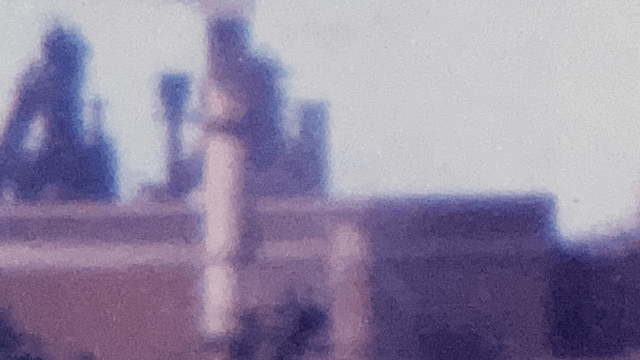
Terri Hughes-Oelrich (California)
Instagram: @hughesoelrich
Make-Buy
stop motion of photograph
2021
Marianne Bickett (Oregon, US)
Instagram: @mariartcart
Usually, embroidery is associated with sweet things like flowers and decorative designs. But I envisioned a grandmother trying to explain greenhouse gases to her grandchild. In this story she explains what each of the molecular structures is:
O=C=O is carbon dioxide that is released from fossil fuel combustion; in the center is methane (4 Hydrogen atoms, 1 carbon) released by coal, natural gas, and oil production and transportation as well as livestock and other farming activities; and in the sides is nitrous oxide (2 nitrogen atoms and one oxygen) that is also called laughing gas that is used as a rocket motor oxidizer, food additive and spray propellant, and many more uses such as a flavoring ingredient and used in surgery. These three molecules are the top polluters that, when they spill into the air, absorb heat from the sun and it warms up our atmosphere. When the grandmother lights up the embroidery, she causes pollution because the carbon molecules are released by the fire. Do not try this at home…for demonstration purposes only. Our innocence goes up in smoke like the innocent embroidery stitches. There is no going back once we realize the truth. We are burning up our planet, but with education and dedication, we can change the outcome of this story.
Thank you to WNFE for this opportunity!
Marianne Bickett ©2021
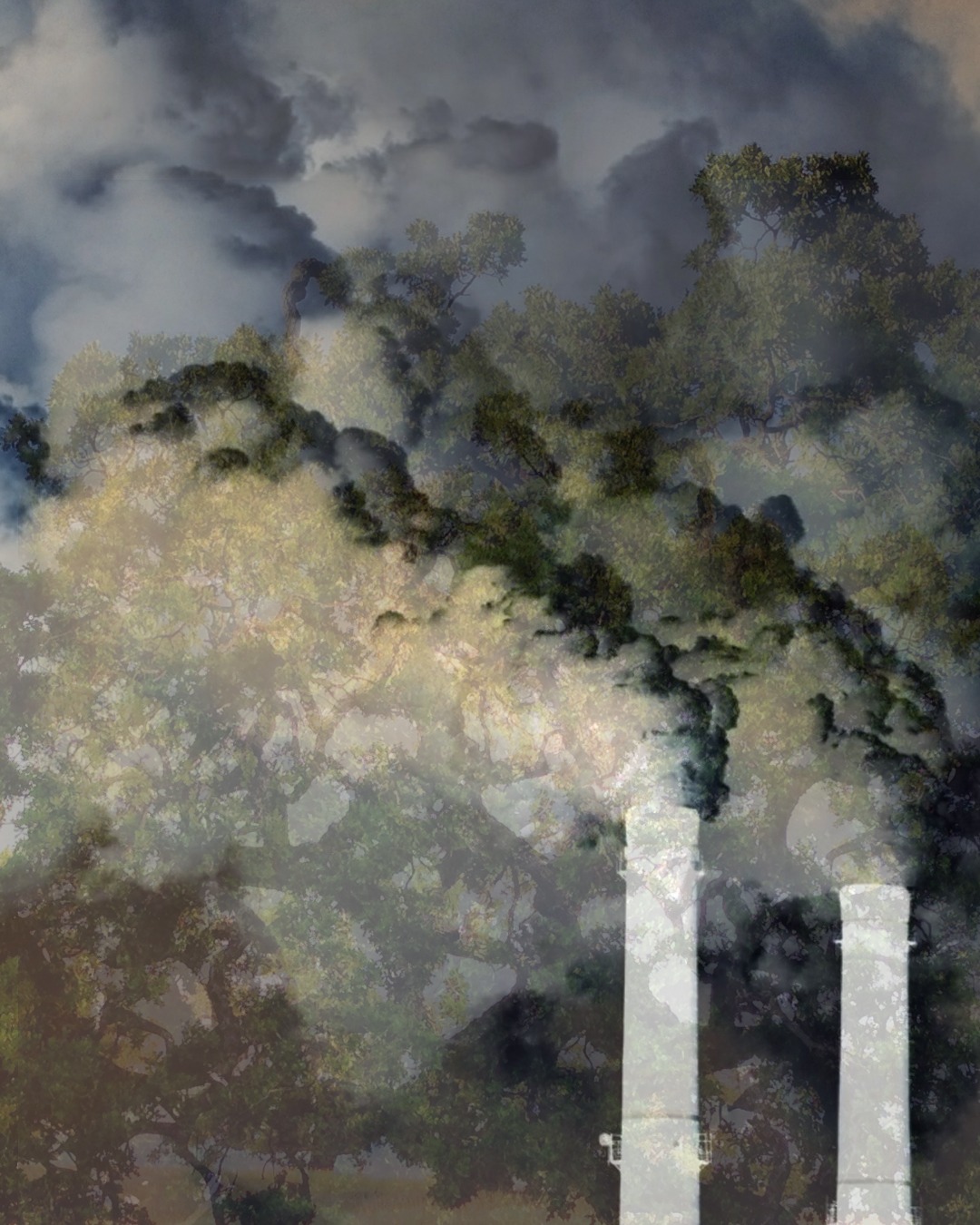
Michele Guieu (Sunnyvale, California, US)
Instagram: @micheleguieu
The genie is out of the bottle
Digital collage
2021
[…] “By far the most serious example of pollution in the world today is climate change, caused by human-produced greenhouse gases. While other pollution may compromise the viability of local ecosystems, climate change threatens the entire global ecosystem. The main greenhouse gases and their primary sources are: one, carbon dioxide, released from fossil fuel combustion; two, methane, released by farm animals and by the natural gas industry (natural gas is basically methane); and three, nitrous oxide, released by agriculture and fossil fuel combustion.”
[…] Since the 1990s the United Nations has sought to rally the world’s nations to reduce greenhouse gas emissions. After 21 years of international meetings and failed negotiations, 196 nations finally agreed in December 2015 on a collective goal of limiting temperature increase above pre-industrial levels to 2 degrees Celsius—which is 3.6 degrees Fahrenheit—with the ideal being 1.5 degrees or less. But actual emissions have so far not been capped. Some of the difficulty in reaching consensus on action comes from the fact that most historic emissions have come from the world’s wealthy and politically powerful nations, which continue burning fossil fuels at high rates, while many poorer nations, which have less historic responsibility, are rapidly increasing their fossil fuel consumption in order to industrialize. Some of the very poorest nations are also the ones most vulnerable to climate change. All of this makes it hard to agree who should reduce consumption and how fast.”
[…] The stakes could hardly be higher. Climate change threatens not just our own species, but millions of others as well. If we don’t solve this single pollution problem, the fate not just of civilization, but of most of the planet’s species may hang in the balance.”
Richard Heinberg,
Think Resilience Online Course
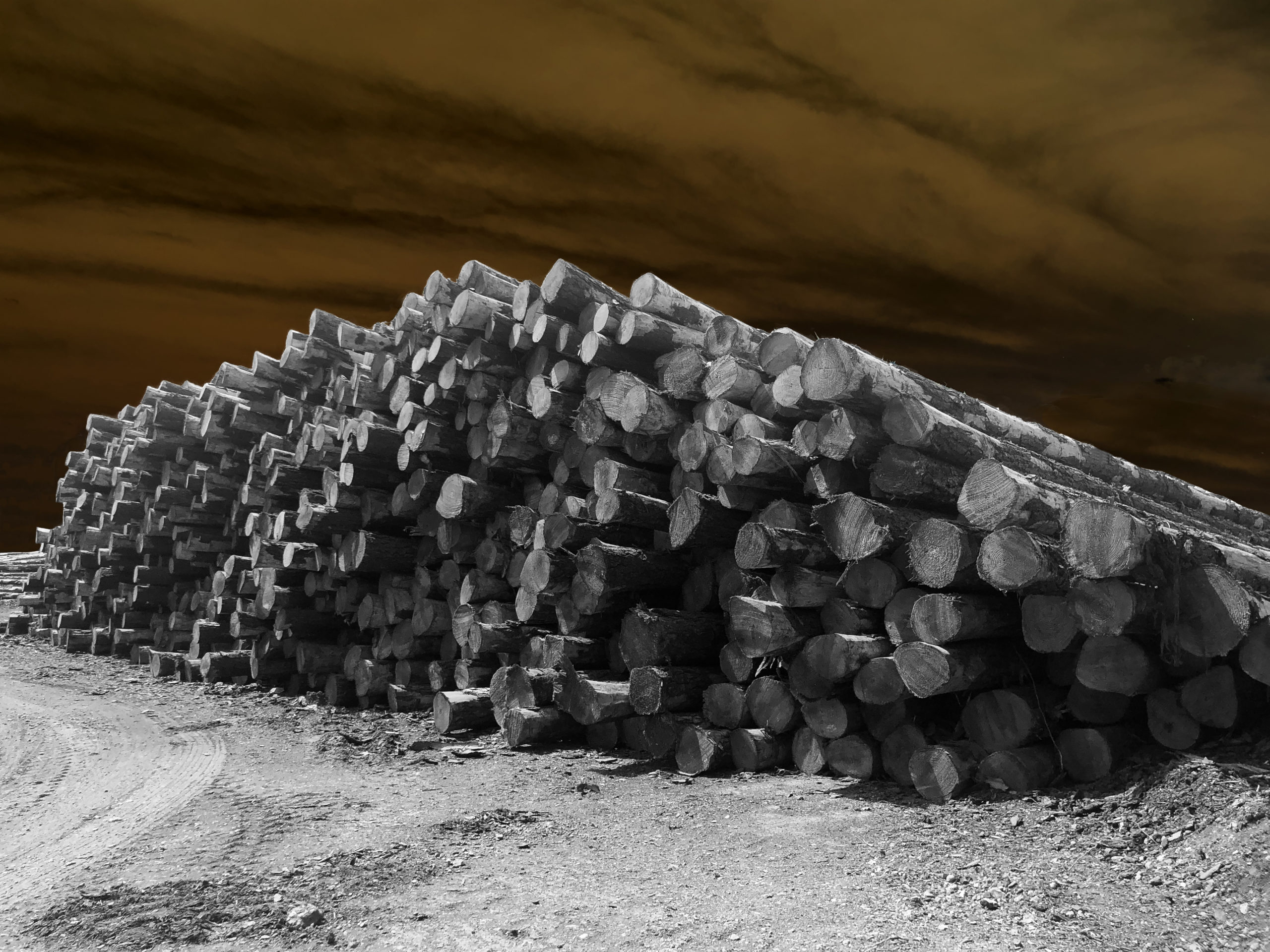
Michele Guieu (Sunnyvale, California, US)
Instagram: @micheleguieu
CO2 is (almost) forever
Digital photography
2021
If we could stop the CO2 emissions tomorrow, it would take 100 years to eliminate 50% of the surplus of CO2 already in the atmosphere. After a millennium, there would be about 20% left, and after 10,000 years, there would still be 10% – which would be there almost forever.
Even if we could stop the CO2 emissions tomorrow, the climate would still evolve for the years to come because CO2 is very stable in the atmosphere. We do not have any technology (at scale) that can remove the CO2 surplus from the atmosphere.
That is why continuing to burn fossil fuels while assuming that these emissions are being offset by planting trees is counterproductive. The challenge is to both reduce fossil fuel emissions sharply and rapidly and, by planting forests, return to the land the CO2 emitted after deforestation.
What’s Next For Earth is an art project created by Michele Guieu, eco-artist and MAHB Arts Community Coordinator, to reflect on the climate emergency, the human predicament and envision a desirable future. The project is supported by the MAHB.
If you have any questions, please send a message to michele@mahbonline.org.
Thank you ~
Follow What’s Next for Earth on Instagram!

